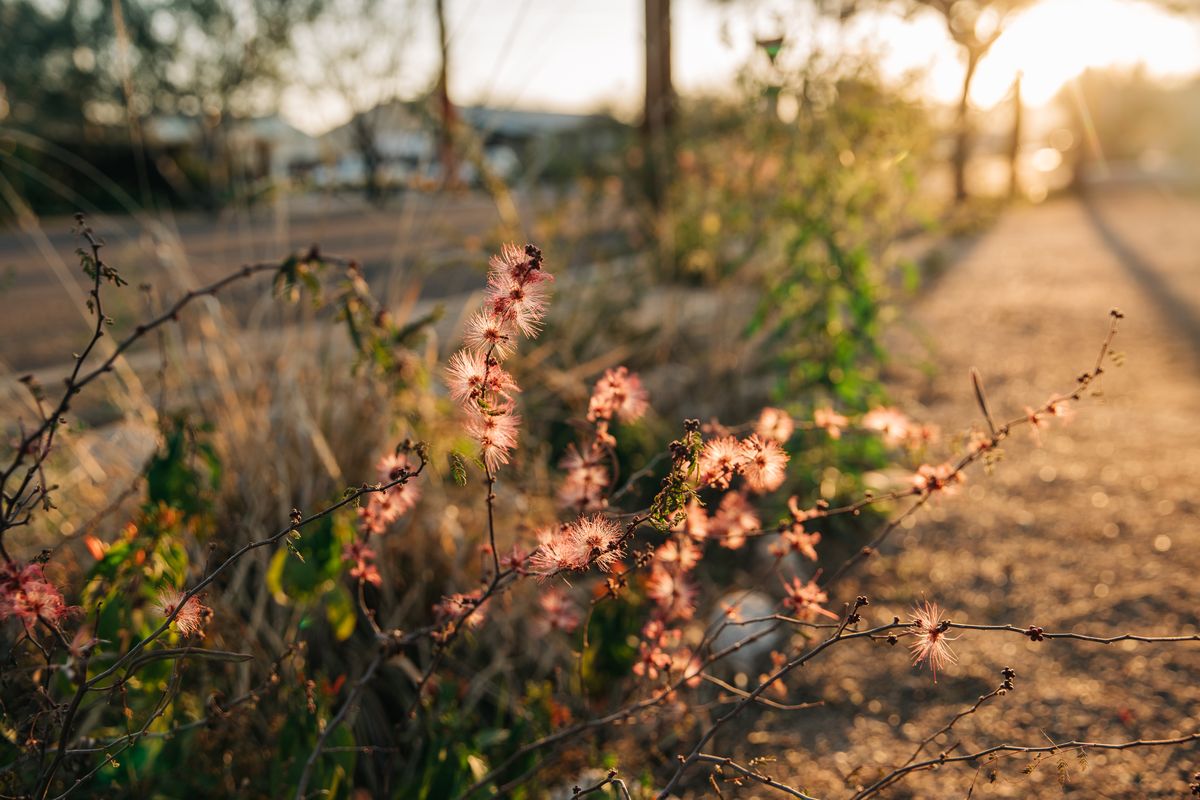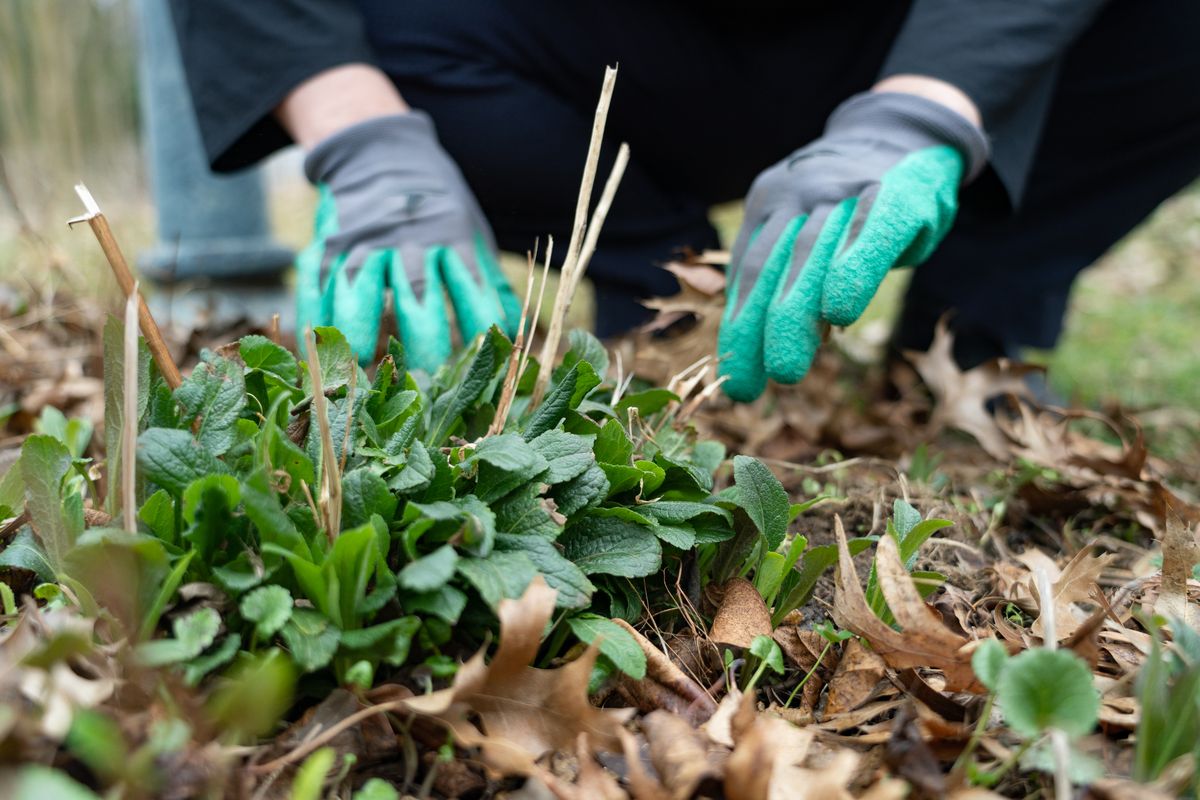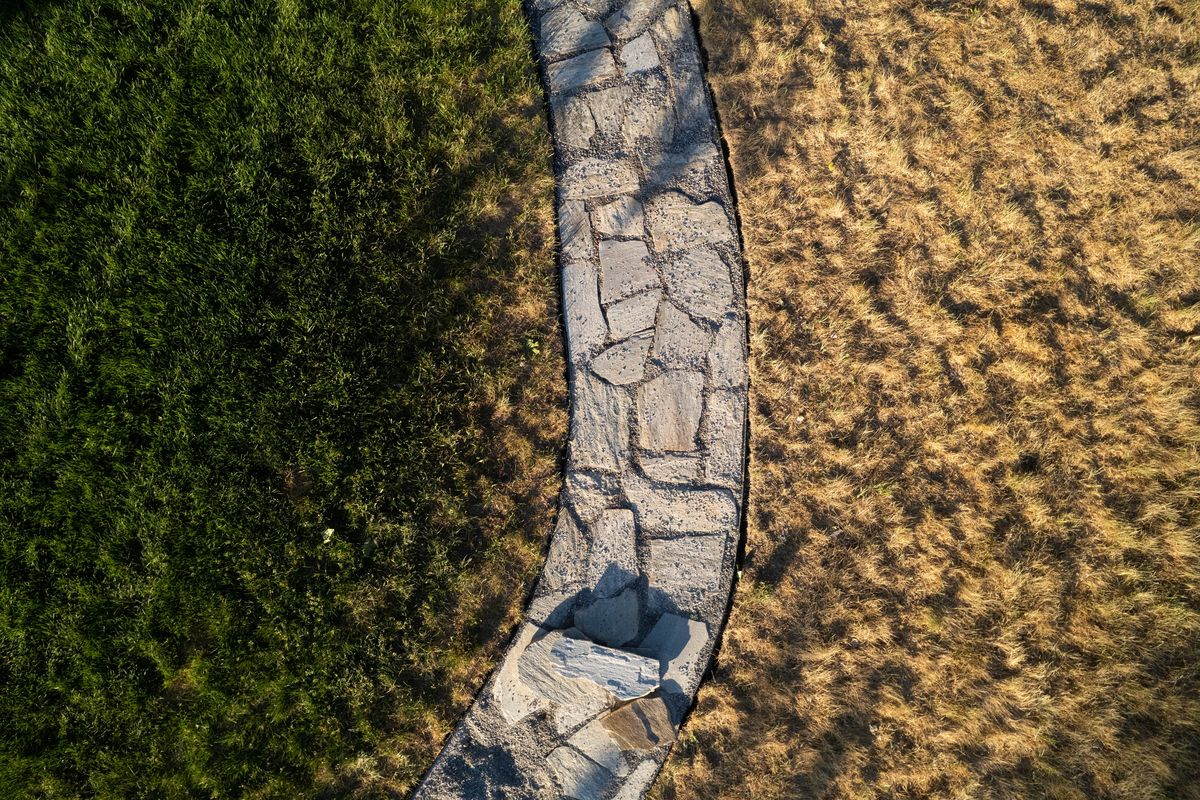Not ready for an ‘ugly lawn’? Try this instead.
An aerial view of Mike Maxwell’s backyard in Draper, Utah, on June 4. Maxwell, chair of the Salt Lake City chapter of LDS Earth Stewardship, is currently killing off 60% of his yard’s Kentucky bluegrass and will be replacing it with water-wise clover and native grasses. (James Roh/For the Washington Post)
This year, a Tasmanian yard that hadn’t been watered in 10 years and featured a dead brushtail possum won the title of ugliest lawn in the world. The contest, organized by the island of Gotland in Sweden, rewards those who turn over their yards to nature to save water and change the world’s perception of the ideal lawn.
It also raises an important question: Who wants an ugly lawn, really? An admirable, dedicated contingent embracing ugly lawns’ ecological bona fides is willing to draw “disgusted glances from neighbors – and a round of applause from around the globe,” as the contest organizers put it.
But far more people just want a nice yard that won’t provoke their neighborhood homeowners association.
“If we’re saying we’re all going to have the ugliest landscape in the world, that’s not going to catch on,” insists Doug Tallamy, an entomologist at the University of Delaware who’s proposing a different approach. “I’m trying to reduce the area of lawn and do it in an attractive way so you’re not thrown out of your neighborhood.”
Tallamy is part of a growing movement to create ecological Edens out of yards while keeping them palatable to society. Want an unruly meadow? Carve a path inviting you in. Planting a profusion of native trees and shrubs? Border it with a strip of manicured grass.
These subtle but crucial signals differentiate a mess from a “lawn.” That might be enough to move wildlife conservation beyond public lands to the backyards – and even balconies – of millions of people, propagating tidy wildlands across the country.
“We need ecosystems to function everywhere, not just in parks and preserves,” he argues.
Here’s how to create a yard – or container garden – that’s good for nature while making you the envy of your neighborhood.
What we’ve lost
Americans have transformed 95% of the natural landscapes in the country. Around half the Lower 48 states are now cities and streets, infrastructure such as airports and shopping centers, or isolated habitat fragments, with farms covering much of the other half.
Only about 13% of the United States enjoys some form of protection.
That’s hardly enough to sustain wildlife. If nearly three-quarters of habitat is lost, ecologists say, then we’re likely to lose three-quarters of species as well. In just half a century, for example, a staggering 3 billion breeding adult birds, or nearly 30% of their populations, have disappeared.
To save America’s biodiversity, Tallamy wants us to share the land. To do this, he’s enlisting private owners of more than 83% of the United States to create what he calls “homegrown national parks” from tiny city plots to corporate campuses. He envisions turning over half of the 40 million acres of lawns in the United States – an area roughly the size of New England – to imperiled native plants and trees, embracing what Aldo Leopold, widely regarded as a father of modern conservation, called the “land ethic.”
“We abuse land because we regard it as a commodity belonging to us,” Leopold wrote in his 1949 book, “A Sand County Almanac,” popularizing the idea that healthy ecosystems are vital to humanity’s survival. “When we see land as a community to which we belong, we may begin to use it with love and respect.”
That means restoring four ecological functions that healthy landscapes perform: nourish the food web, supply clean water, pull carbon out of the air, and feed and shelter native insects and pollinators.
“Lawns do none of them,” says Tallamy. But they could, on almost any scale, including a tiny side yard or even a container.
Imagine your yard as a buffet. Insects evolved over millions of years to feast on hundreds of regional cuisines made up of native plants from Florida to the Pacific Northwest. Some, such as the monarch butterfly larvae, depend on a single endemic plant species. If all you have to offer are turf and ornamental plants, mostly from Asia and Europe, you might as well be growing AstroTurf.
That leaves insects and everything that depends on them – including the roughly three-quarters of all the flowering plants on Earth they pollinate – out of luck. A 2019 study by Tallamy and others found hedgerows infested with invasive shrubs and trees supported 96% fewer caterpillars, by weight, than those dominated by natives
Since so many animals eat caterpillars, says Tallamy, without them you have a failed food web.
Tidy wildlands that even the most conservative neighbor could celebrate could restore nature’s banquet table, and all the wildlife that relies on it, across U.S. cities and suburbs.
What the new yard could look like
The typical objection to “natural” yards and native plants boils down to one word: “messy,” says Haven Kiers, a landscape architect at the University of California at Davis.
The public perception of lawns is binary: clipped and manicured or abandoned and ugly. Kiers is charting a third way, transforming her own scraggly grass lawn in Davis into an explosive profusion of native plants combined with a few ornamentals that people and pollinators love.
“It would be great if everyone planted only natives,” she says, “but I’m also dealing with a public that wants to do well and wants gardens to look good.”
So she’s designing native landscapes as formal gardens. Her students lay out elaborate botanical landscapes that draw on ordered garden styles while using only plants from the West. Ironically, this may mean reintroducing them to Americans in a new light. Our native plants such as pokeweed, American sweetgum and Virginia creeper are fixtures in formal gardens in Paris, and elsewhere in Europe. We just need to learn to love them as much they do.
The key is a landscape philosophy called “cues to care.” First introduced in a 1995 paper called “Messy Ecosystems, Orderly Frames,” it argued that intentionally designed elements – mowed grass margins, flowering plants with crisp edges or trimmed shrubs – should delineate larger “messy” wildness such as a meadow or prairie gardens. These signs of human presence make the landscapes socially acceptable, while preserving their ecological value, which is often invisible.
Ultimately, the lack of social acceptance is what makes the “ugly” frame such a hard sell. Yards are not afterthoughts for most people. They are status symbols and artistic expressions. To make native landscapes acceptable, we need to marry human touch with ecological function.
How to create a tidy wildland
Take it one small patch at a time. Kiers recommends slowly replacing strips of lawn with native (or a few suitable ornamental) plants that can support pollinators and local fauna. For Kiers, the backyard is a work in progress. With each passing year, her grass recedes as her garden beds and natives grow.
And if you’re worried about HOA restrictions, most rules are about preserving property value. The “cues to care” mean your HOA may accept your native yard – or you can join your HOA to ensure it changes its rules.
HOAs are also losing their clout: a low-impact landscaping law passed in Maryland prevents homeowners associations from prohibiting environmentally friendly yards. Florida, Utah, Arizona, California and other states and cities have similar laws on the books or under consideration.
Go native – but no need to fear all ornamentals. Native plants will give you the biggest ecological bang for your buck. Typically, they won’t need water after they get established. Start by asking your native plant society or nursery. There’s one in every state, or search for master gardener groups and extension services online in your area who can answer your questions (for free!).
Adding ornamentals to the mix can add appeal without losing much ecological value. “There’s so much pressure to only go native,” says Kiers. “That’s silly.” Just prioritize natives and avoid invasives.
Plant keystone species, feed the food web. These plants support the most wildlife. White oaks and relatives, for example, are exemplary trees for wildlife in 84% of U.S. counties.
And don’t forget to leave areas under trees and shrubs with leaves, logs or small native seedlings. More than 90% of the caterpillars drop off their host plant and need ground cover to finish their life cycle.
Spread seeds for an instant flower garden. Any clearing at the edge of a path, around a tree or even a sidewalk can become a thriving garden with a few seeds and some occasional watering. If you do buy potted plants, use small pots (1 gallon versus 4 gallon), as the plants are more likely to thrive.
Don’t have a lawn? Plant a balcony or become a guerrilla gardener. Biodiversity can thrive on your balcony, terrace or rooftop. Containers are “refueling pit stops” for native pollinators, says Homegrown National Park. Large pots are best, and some perennial species will return year after year.
And there are plenty of forgotten spaces where a wildflower garden can take root – you don’t even need to own it. Throw a few “seed bombs” on bare ground, and after some initial watering, a native garden can bloom almost anywhere from a Brooklyn sidewalk to back alleys.
Express yourself. The natural world has a nearly infinite variety of species for you to grow into. After some trial and error, you may find yourself as more than a gardener, but the creator of your own tidy wilderness.
“The good news is that we can fix our ecological problems by indulging rather than sacrificing,” says Tallamy. “It has been very difficult to address environmental issues by asking people to give up something.”
You can share and map your new yards with Homegrown National Park.


